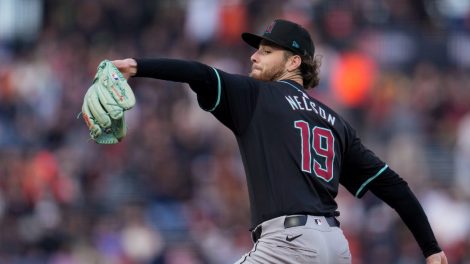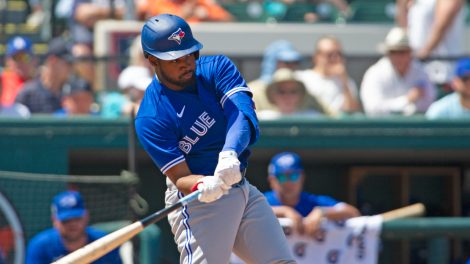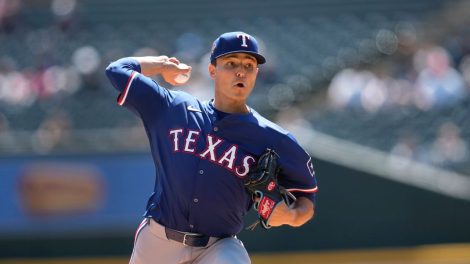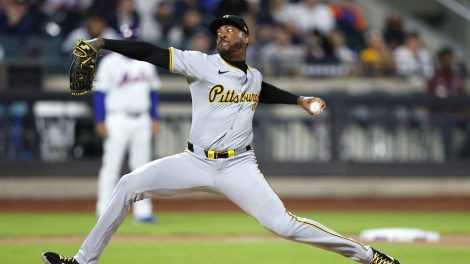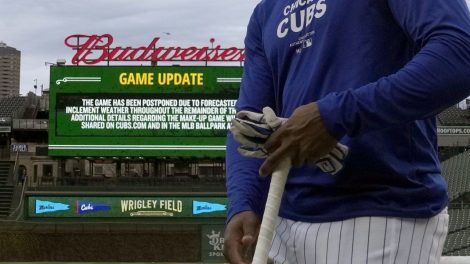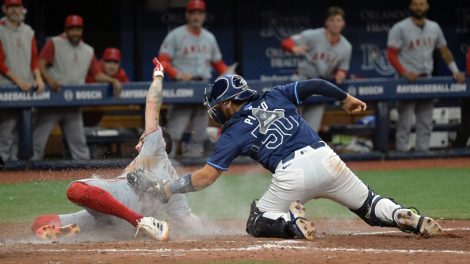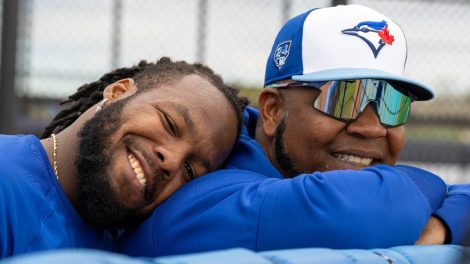When the Blue Jays acquired R.A. Dickey in December of 2012, I found myself caught up in the moment, like many Blue Jays fans. Though I confess to a level of hesitation in embracing the trade that brought him to Toronto, I still found myself going through MLB.TV archives and watching a lot of video from the dominant starts of his Cy Young season.
In that initial exposure to the knuckleballer, there was a level of unease at watching his performances. Somehow, the reality of watching a knuckleballer deal wasn’t nearly as thrilling as the idea of it.
To that point, most Jays fans were exposed to Dickey through carefully constructed highlight packages, including super-slo-mo treatments of dancing floater balls eliciting weak swings. It helped to feed into the anticipation of what the new staff ace could deliver in terms of results, but also in terms of entertainment value. The whole idea of a knuckleball pitcher seemed like something romantic, plucked from another era of the game. It felt like it was going to be special.
Knowing Dickey’s award-winning pedigree, it was easy to fall into the expectations of what a number one pitcher should be. They’re the staff leaders, and the stoppers. The guys who exert themselves over even the best offences. The pitchers who take control of games when things start to get away from them.
But upon subsequent viewings, there was something unsettlingly drab about Dickey’s performances, even when the results seemed to indicate that he had been dominant. While Dickey’s story generated much enthusiasm in the second half of 2012, his performances weren’t the electrifying displays of Pedro Martinez, or the mastery of Greg Maddux. He may have been effective, but he wasn’t exciting. Watching Dickey at game speed, at bats and innings unfold in an oddly passive fashion.
Blue Jays fans had become accustomed to that sort of staff leader, from Roy Halladay back through Roger Clemens and Pat Hentgen and Dave Stieb. (Oddly and incidentally, you could argue that neither of the World Series teams had an ace in their rotation. But that’s a discussion for another day.) But Dickey is not that sort of pitcher. Not close.
Where those prototypical aces could rely on spotting their fastballs smartly when the going got rough, Dickey’s arsenal is such that he’s beholden to an uncontrollable pitch with erratic movement, even when behind in the count. If Dickey gets ahead, then he can deal that fluttering balle papillon to great effect in the same manner that Clemens would use “Mr. Splitty” or Stieb would use his wickedly effective slider. But get a runner or two on base and put Dickey up against a quality hitter, and he’s left to rely on a pitch with whose capricious nature he regularly admits to struggling.
The whole concept of a staff ace in baseball is something of an artificial construction, but it exists in part because of a psychological need on the part of teams, their players and indeed, their fans. In a game so unpredictable, having someone steadfastly reliable take the mound every fifth game helps to assuage the anxieties and calm the nerves.
R.A. Dickey is clearly not the sort of pitcher who offers something resembling certainty or serenity. It’s not to say that his results have been wholly disappointing, because as his most recent start would indicate, he can be a very effective pitcher at times. Moreover, though his primary pitch is somewhat unreliable, Dickey has reliably taken his turn in the rotation, and only twice in his tenure with the Blue Jays has he given fewer than five innings of work.
It may be a given for some that Dickey isn’t a number one pitcher, and that he never should have been viewed this way. You could make the argument that his last season with the New York Mets was the high point in his career, but otherwise, even a positive reading of his last five seasons gives the sense that he’s a veteran mid-rotation innings eater.
That might seem obvious to some, but it could be argued that a significant portion of fans are left disappointed because they still expect ace-like results from the team’s opening day starter. Because of those lofty expectations, Dickey’s positive contributions have slipped into the realm of the underappreciated. Following his fine outing on Tuesday, Dickey’s ERA sits at 3.86 for the season, which ranks better than Ervin Santana (4.01), Homer Bailey (4.15), Ubaldo Jimenez (4.52) or Brandon McCarthy (4.80). And he’s almost a full run better than fellow Cy Young laureate Justin Verlander (4.84).
If fans can shed the notion of R.A. Dickey serving in the role of the Blue Jays’ ace, and accept that he is a mid-rotation contributor who shows up regularly and acquits himself fairly well, could they embrace him?
It could be a tough sell, in part because of the substantial package the Blue Jays sent to New York to land him. If you thought you were acquiring a number three or four pitcher, you probably aren’t sending two of your top three prospects to get him. On the other hand, despite of the upfront cost, Dickey’s $12 million annual salary makes him the 75th highest paid player in the game, and while it would be a stretch to call him underpaid, his salary isn’t a substantial burden.
In the context of an increasingly impatient and dissatisfied fanbase, it might seem presumptuous to ask people to lower their expectations of anyone on this team. But if you burden R.A. Dickey with labels or roles to which he is ill-suited, you’ll never fully appreciate what he can contribute to a winning team.


